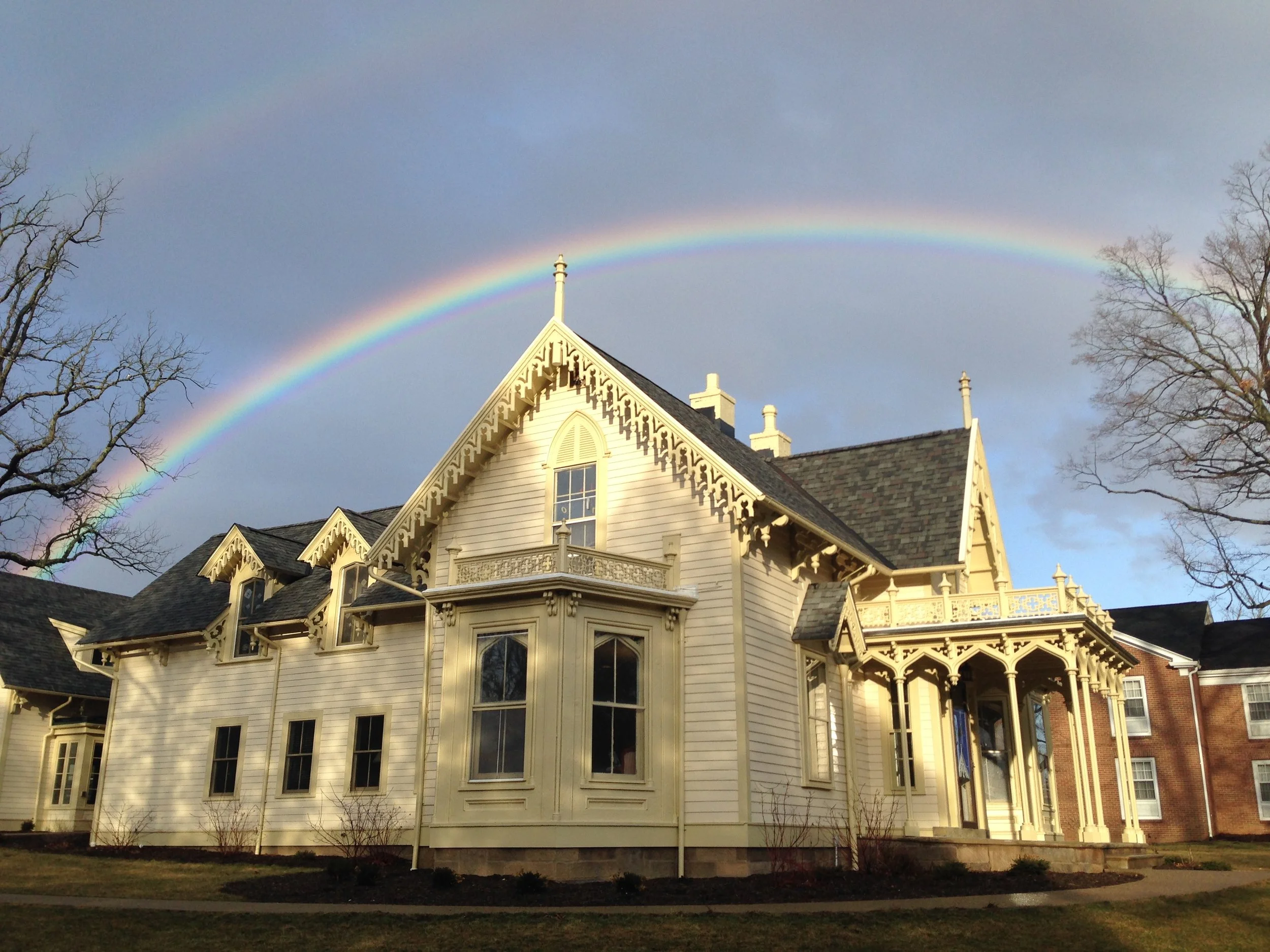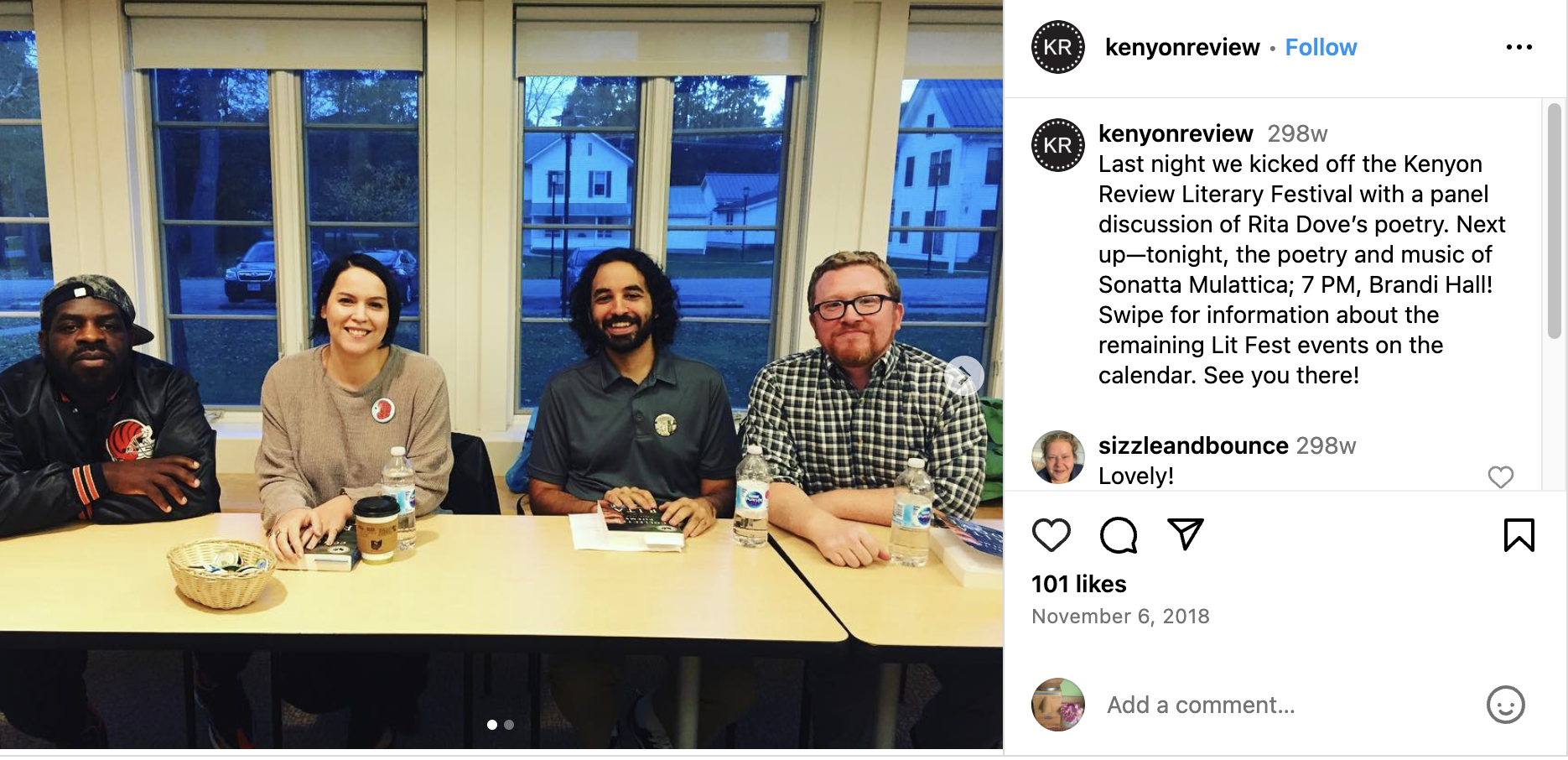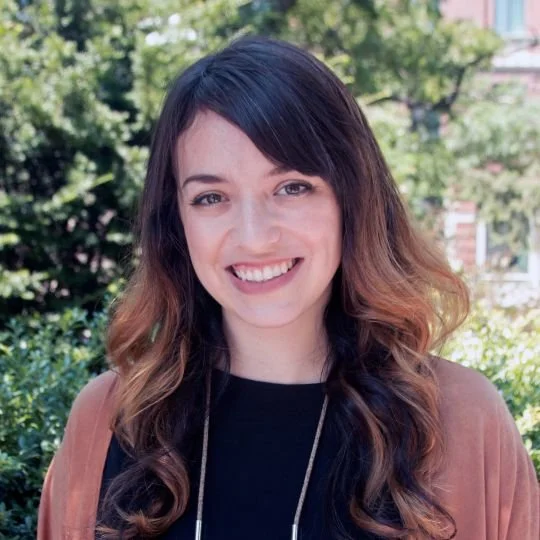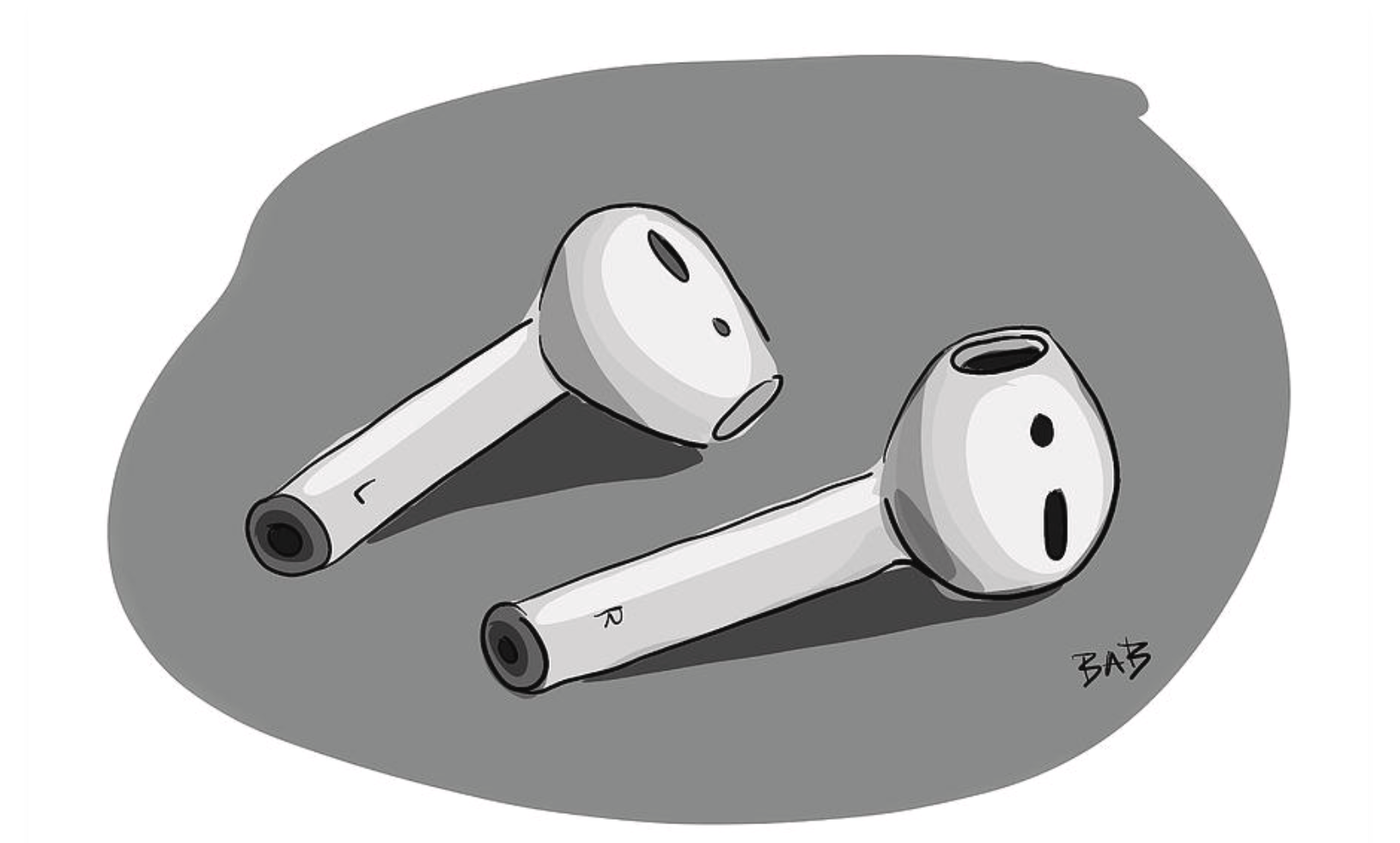In today’s newsletter: Nothing about Kamala Harris or Trump; this won’t be soon enough to cover the Olympics (though we’re all relieved about Simone Biles). Jump ahead to view a guest issue of the newsletter by Kirsten Reach.
I’m Kirsten Reach, an editor. Jonquil Editorial is my editorial consulting firm, and I work with publishers as well as authors like Ruth Awad, Jacqueline Alnes, and Ilya Kaminsky.
Learn more about my current authors, or check out my newsletter.
Where do your readers start with each issue of the magazine?
Is it flipping through, looking for one author in the table of contents?
Writing
My first email as Kenyon Review editor was to Hilary Mantel, whom I’d worked with at Henry Holt on her two Man Booker Prize winning titles. I invited her to receive our Award for Literary Achievement, and she and her husband Gerald flew in to Gambier and New York to accept.
My next goal was to form new connections
Following the initiative of a board member, Marcy Barr-Abbot, I built an alumni network for former associates of the Kenyon Review. We met in New York, L.A., DC, and other cities that aligned with the AWP Conference. I scooped ice cream for our visiting alumni annually, and arranged readings for the same event. With our reading at Friends & Lovers in Brooklyn, over 100 people were in attendance (even a handful who were on the New Yorker staff)!
-
To see if authors I love are in these pages. Then I save the issues for them, or take photos for socials.
-
Like Liana Finck. This cartoon is from her August 7 newsletter.
-
And mark the feature from the writer I most want to read with a subscription postcard. I use another to hold my spot as I read from the beginning.
Is your audience wildly different for this newsletter than other formats?
When I worked for the Kenyon Review, we found that print readers were generally male, over 55, Jewish, and living in New York. Our online magazine readers were generally female, between 25 and 40, and living in a completely different part of the US.
I tried to reflect this visual identity in our social media channels. To build on this nostalgic feel, I pulled together items from our office to style our covers for Instagram before each issue’s launch (like this one from Jan/Feb 2017).
I made an effort to highlight our fellows and local writers in conversation, like this Rita Dove panel from 2018. We launched our YouTube channel around this time, and it was a bit of a learning curve — we eventually designed a banner to improve the professional look on video, and found better ways to handle our sound in the small space. We added a leading image with large text to introduce each reader, and to save us from messy still shots.
One of my proudest AWP moments was convincing editors from Tin House and One Story to throw a dance party with the Kenyon Review. We pooled funds for drink tickets and invited some of our favorite writers to come up with the playlists. It was packed! It helped to boost engagement with younger writers, and many of them submitted to us the following year.
One of our biggest, and most successful online events was "A Winter Evening of Poetry and Song" with Shira Erlichman, Ross Gay, and Saeed Jones. This was one of our first live events with closed captioning. This was an event where we followed the lead of our speakers, and it felt like their creative energy fused, even from a distance, in the early stages of the pandemic.
We were able to hire exceptional fellows, and run a vibrant reading series
I served on the Fellowship search committee and worked with the KR Fellows to guide their independent publishing projects through the production process. Like you, we were concerned about in-person spaces that suffered during the pandemic, as well as the writers who couldn’t launch their titles in person. The initiative eventually became “On Books and Their Harbors”—a series by authors published during the pandemic about the bookstores they missed most, led by Misha Rai and Molly McCully Brown. In years before that, we published “Proof Casts a Shadow,” an international conversation about how artists can engage with a world that threatens the bodies of its least protected, led by Keith S. Wilson and Misha Rai; and “Resistance, Change, Survival,” space created for authors who were speaking out of silenced experiences (in the wake of the 2016 election), led by Jaquira Díaz and Margaree Little.
Joined Chang-Rae Lee and Misha Rai for a Q&A at 36:16.
“Coffins Patch” by Rachel Heng (Jan/Feb 2021). Rachel studied with former fiction editor Nancy Zafris, who wrote to connect us. I published her story “You Know I Want It Ice Cold” in our online magazine, and we kept in touch. This was a tender story about miscarriage, and I’m grateful we built the kind of editorial relationship where she would send us new work that took these kinds of risks. This was the first story I was able to accept under our new editor, Nicole Terez Dutton.
“Snow Line” by Elizabeth Brinsfield (Mar/Apr 2019). The author and I revised this over the phone for months. The climax is composed of many small gestures in a tight room, and as we tried to order them, I drew a map so we could work out where the table was, where the protagonist’s son was, and where the dangerous neighbor was standing—between the pregnant protagonist and the door.
A small detail I love: the author includes a mention of deer, and the timing of these was significant, since the population died out almost completely and returned by the year in which the story was set.
“Butter” by Eve Gleichman, winner of the Short Fiction Prize (Jan/Feb 2017). I managed submissions for the prizes, hired the guest judges, and worked with student interns to narrow the pool down to about ten submissions. My intern and I were thrilled with this piece when we met in my office to discuss it, and I called her as soon as we got the final word from Jaimy Gordon that it had won. Later I invited Eve to read in Brooklyn as part of an alumni event at Friends & Lovers, and years later they sent us “The Quiet Current,” which I published in July/August 2020. Eve co-authored a novel, The Very Nice Box, with with Laura Blackett. It was a New York Times Editors' Choice and an Apple Book of the Month.
“On Poverty” by Alison Stine (February 2016), a response to Claire Vaye Watkins’s “On Pandering,” took us months of work. We had published Alison’s poems many years ago, and she approached us by email with an idea for a post. As the months and drafts went on, I encouraged her to make this less a criticism of Watkins’s dismissal of rural Pennsylvania and to make the argument independent of this piece.
Her blog post became our most-trafficked piece on the Kenyon Review site, and it was the first blog post at KR ever nominated for a Pushcart. Since this hit piece, she has continued to pursue writing about being a writer and single parent living below the poverty line in rural Appalachia.
Mia Alvar was gracious enough to serve as judge for the 2019 Short Fiction Prize. Winner Daphne Palsai Andreades read her story outside of the office on the last day of our summer workshop. “Brown Girls”—first published in our contest the Kenyon Review—was selected by Chimamanda Ngozi Adichie for an O. Henry Prize, and was sold as an expanded project to Random House (US), 4th Estate (UK), Luchterhand (Germany) and Les Escales (France).
Overseeing our three book review editors, we launched a new page to review 100 books a year
Adam Clay, Corey Van Landingham, and Richie Hofmann helped us launch this enormous project to draw attention to titles from small presses and academic publishers.
Janet McAdams led our micro-review section, commissioning very short reviews on titles that might be overlooked by larger institutions.
I helped to implement these initiatives for the journal, and managed the staff they required. I’m proud of the editors and our reviewers for their enormous reach, and for something that feels so necessary. But I maintain that “KR Reviews” is a redundant name for the book review section.
Audio interviews
The night Rita Dove accepted the Award for Literary Achievement in New York, our student associates gave readings from the book accompanied by a performance of Beethoven’s "Violin Sonata No. 9" by Alayne Wegner. For context, Rita Dove’s Sonata Mulattica focuses on the relationship between Ludwig van Beethoven and biracial violinist George Bridgetower. Our social media team had to be on the ground in both locations.
Selections from the work I solicited, edited, and published at the Review
I wanted to make our literary arts organization, and our publication, visible to readers all over the world
Intro for Misha Rai's reading begins at 18:28.
Another board member suggested a weekly newsletter to highlight pieces from our archive. For six years, I selected items from the archives, and began to select pieces from Kenyon Review Online as well. Our clickthrough rate was remarkably high, and we were able to get some attention for our older pieces on social media. This enriched our readers’ understanding of the journal’s history and put the pieces in conversation with pieces we’d published only days before.
Colm Tóibín accepts the Kenyon Review Award for Literary Achievement at the Rainbow Room in NYC on November 9, 2017. The highlight is the final moment of his talk when he traces the word "thole," which appeared in an Old English work he was translating, through Scotland to Northern Ireland, to "Here Lies A Lady," a poem by John Crowe Ransom, founder of the Kenyon Review. This may not have as much appeal for our younger readers and followers, but it's another moment we were able to see a strong connection between our publication and the history of a single word.
But the lasting record of the journal was keeping me up at night
Jeff VanderMeer’s article about the end of Black Clock in LitHub reminded me to speak with others about how to protect our magazine in the future. I initiated a meeting with our managing editor, Abigail Serfass, and librarian Jenna Nolt to strategize ways to back up the physical and digital magazines in the Kenyon College archives. Jenna was brave enough to take on the project, and we created internships during the pandemic to have students scan pages from the original issues. This fit with the college’s larger goal to provide additional work opportunities to engage students in their first year of remote learning. It was also an easy sell to our board: Kenyon was already investing in the technology we needed to ensure the journal would be preserved for future generations.
Working with a student intern, I took new risks with our audio offerings
Though we had a clause in our contract about audio rights, few authors took the time to record themselves reading their own work. A student intern, Tyler Guerin, asked if he could read pieces and record other student associates or theater majors doing the same. I worked with him on Kenyon Review Out Loud, a new audio effort to make each piece in the magazine available to hear—often in the author’s own voice, but if not, by a student or editor from the magazine.
My introductions are available from the Kenyon Review.
I’ve freelanced with Static Media, and wrote a couple of pieces on slow editing days. Chocolate peanut butter treats from Ohio seem to be my beat.
Melville House and if:Book have been reimagining their websites, so hundreds of articles are buried at the moment, but I’m happy to send additional clips upon request.
If you look closely, you’ll see that the pages in the foreground are from Ann Hamilton’s “human carriage” (installed at the Guggenheim in 2009), which were in a staff member’s office.
We hosted seven to twelve readers per semester at Kenyon College in Gambier, Ohio. As associate editor of the magazine, I worked with Stella Ryan-Lozon to host this series, introducing each reader, working with interns to design publicity materials, hosting dinners for each guest, spreading the word about any recordings we made during their visit, and connecting them to our students.
As the series grew, we became more ambitious about creating high-quality film recordings and making them available for free with closed captioning.
Our audience and our reach were expanding significantly.
Our Twitter following expanded from 9,000 when I arrived to more than 55,0000—the largest mouthpiece for the college, not just our magazine
Other career highlights
One of five Melville House staffers to pull 34 hours at their desk to crash the Senate Intelligence Committee’s Report on Torture just days before Christmas. Alexandra Schwartz covered this.
I read a great review by Celeste Ng in The Guardian and negotiated with her agent. The Girl in the Red Coat was our first title in Costco, and received a rave from Michiko Kakutani in the New York Times.
Reached out to a young writer I admired, but found her first book would put her at legal risk. I advised her to contact a lawyer, and told her if she ever reimagined the story as fiction, I’d love to see it. Years later, she wrote back. I acquired and published Catie Disabato’s hit novel The Ghost Network.
Visited the coffee shop next to the Melville House office, Brooklyn Roasting Company, and convinced them to make a special coffee to align with our publication of Jeremy Bushnell’s novel The Weirdness (in which a writer makes a deal with the devil to publish his first book).
Crossed the river on the ferry at 5 a.m. each day after Hurricane Sandy took out our PATH trains in Jersey City. I commuted more than two hours each day to Grand Central, where I worked furiously to get out copies of Jami Attenberg’s The Middlesteins.
With Helen Atsma, I worked on titles by Jane Goodall, and with Gretchen Young, the early draft of Elizabeth Alexander’s The Light of The World. Joined Team Patterson for James Patterson’s mass market editions at GCP.
With Helen Atsma, worked on Mennonite in a Little Black Dress by Rhoda Janzen, a #1 New York Times Best Seller.
With Jack Macrae, worked on a number of titles by Hilary Mantel, including her Man Booker Prize winners Wolf Hall and Bring Up the Bodies. Rewrote and negotiated an exceptionally complicated contract as Wolf Hall became three novels, and the book we’d planned to publish first was pushed back.
Working for Jack, I was the lead contact for his imprint, John Macrae Books. We published titles by Calvin Tomkins, Cameron McWhirter, Carl Safina, and more.
Secured rights to many images for Velázquez and ‘The Surrender of Breda’ by Anthony Bailey for John Macrae Books.
In my role as Researcher at the Institute for the Future of the Book, working with MacArthur “Genius” Bob Stein, I led publicity and an editorial conversation for The Golden Notebook Project: an interactive reading experiment including Naomi Alderman and Helen Oyeyemi
“Why We Chose It”: On “He Comes to Feed the Horses” by Mary Terrier
I was part of this interview with the Kenyon Review staff in LitHub.
Thanks for reading.
Want to hear more? Sign up for the Jonquil Editorial newsletter.
This guest edition of the New Yorker newsletter was written by Kirsten Reach. Contact your guest editor at kirsten@jonquileditorial.com.
You’re receiving this e-mail because I’d like to write the weekly newsletter for The New Yorker.
Email me directly | Website | LinkedIn | Call | Unsubscribe


































